He was getting what I mentioned before in my post. It's high stiffness and very low elongation make it a terrible coil spring especially.lol blackspire, it can too flex mate.
Carbon coil springs
- Thread starter Trekrules
- Start date
Just an idea. What if the spring would have the shape of something like this ? It'd actually be a leaf spring, wouldn't it? It should be easily manufacturable, wouldn't have torsion twist and could have variable progressiveness ...
He was getting what I mentioned before in my post. It's high stiffness and very low elongation make it a terrible coil spring especially.
Just an idea. What if the spring would have the shape of something like this ? It'd actually be a leaf spring, wouldn't it? It should be easily manufacturable, wouldn't have torsion twist and could have variable progressiveness ...
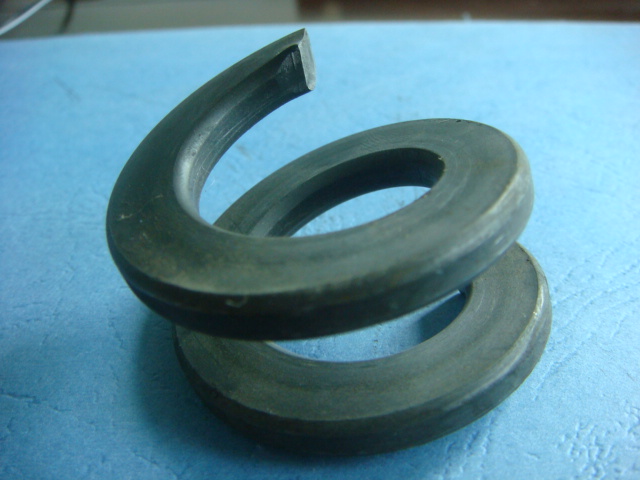
Bad representation, but I always thought that you could reproduce something similar to this in CF.
But I really haven't experimented with this and whilst it would be possible, why would you bother when a Ti spring seems so much more suitable?
I think there is a future for CF in MTB, but a spring?? Develop air I say, you at least get great adjustability for tuning. I would like to experiment with airbag one day. But I can't see a CF spring giving my bike any sort of noticable advantage over Ti really. At least with air I can fine tune without the cost associated with spring replacement.
I might try making a CF spring one day for a laugh, but I bet for the price of manufacture I would never pay retail for one,

There are better uses for CF in our industry for sure.
Last edited:
Somebody that I went to school with suggested making a belleville spring if any out of CF. I had to look it up too.
The big concern that I have with any of the CF springs is with abrasion against the shock body. Carbon fiber does not take abrasion very well and both the stock steel spring and the ti spring on my RC4 are rubbing the shock body and the reservoir.
The big concern that I have with any of the CF springs is with abrasion against the shock body. Carbon fiber does not take abrasion very well and both the stock steel spring and the ti spring on my RC4 are rubbing the shock body and the reservoir.
Carbon fiber doesn't work as leaf springs. However there are composite materials that does, such as the one used on some Corvettes. However that design require more space than a conventional coil spring damper. Also it must be noted that a material should be used to it's fullest possibility. In swedish there is a parameter called materialutnyttjandegrad (n) which translates roughly to material utilization grade. Basically it's an indicator of how effective a spring is using its material. A simple coil spring with a solid cross-section has n = 50%, a coil spring with outer radius b and inner radius a has n = (1 + (a/b)^2) / 2. A leaf spring that is layered and reduced where tension is low can have up to n = 33% but a leaf spring with the same cross-section through-out has 11%.Just an idea. What if the spring would have the shape of something like this ? It'd actually be a leaf spring, wouldn't it? It should be easily manufacturable, wouldn't have torsion twist and could have variable progressiveness ...
Why then would you use a leaf spring design? Well if you can incorporate the leaf spring in the design somehow and utilize it by making it fill another function that just being a spring. But that isn't the case in the leaf spring you pictured above. So it would end up being heavier than a conventional coil spring.
Instead what you can actually do is try make a coil spring with an inner and outer radius, that will make you lose some weight. However it would require expensive manufacturing.
Edit: Also Jason4 mentioned Belleville-springs. These have material utilization grade that is very high. It's not 100% when you take into consideration friction etc but still very high. However these springs are not very good in this application, they have very special charesteristics when used in longer travel applications. If you want alot of travel from this type of spring it will eventueally weigh alot more than a coil spring, have degressive charesteristics in the end of stroke, friction that causes damping and it will need some kind of steering element to keep it in place. So in the end it is not a good solution for this kind of problem.
Last edited:
yes they do... and im sure Massa can attest to thatFrom what i understand F1 cars run steel springs?
I couldn't figure out how the belleville spring would work without a sleeve (steering element as you put it) that would prevent displacement in an undesired direction. I'm excited to see people push the limits of materials and new design ideas but if CF is going to be used as a spring the form needs to be rethought.Edit: Also Jason4 mentioned Belleville-springs. These have material utilization grade that is very high. It's not 100% when you take into consideration friction etc but still very high. However these springs are not very good in this application, they have very special charesteristics when used in longer travel applications. If you want alot of travel from this type of spring it will eventueally weigh alot more than a coil spring, have degressive charesteristics in the end of stroke, friction that causes damping and it will need some kind of steering element to keep it in place. So in the end it is not a good solution for this kind of problem.
mtb news.de head some pictures made
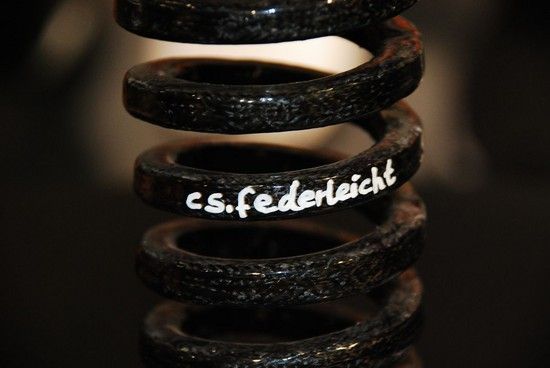
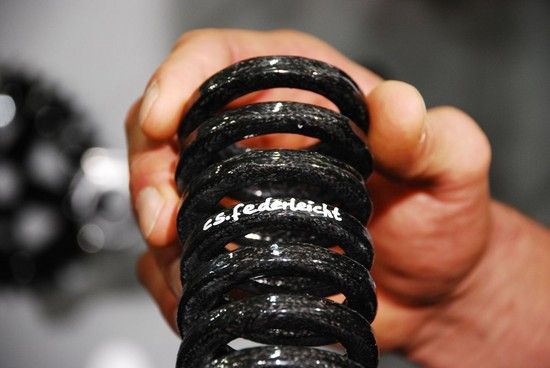
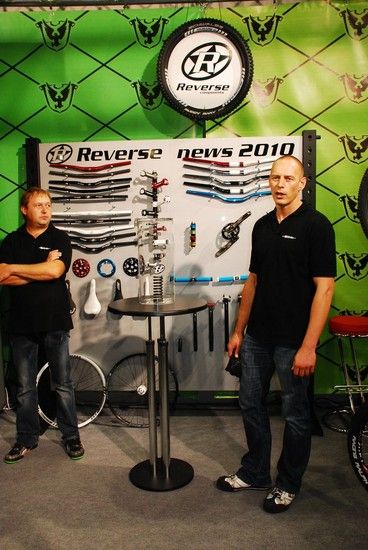
Der Vorteil ist im Grunde offensichtlich: Carbon ist sehr belastbar, damit lassen sich sehr leichte Rahmen herstellen. Und jetzt auch Federn. Warum das Sinn macht, wo es doch leichte Luftdämpfer gibt? Downhill-Fahrer schwören aus Performance-Gründen noch immer auf schwere Stahlfederdämpfer, die Carbon-Federn haben für sie ein enormes Potential:
Gewichtsersparnisse von mindestens 50% gegenüber Stahlversionen, eher 60-65% lassen Titanfedern alt aussehen und wären somit eine Revolution für den Federungsmarkt.
Herstellungstechnisch sind alle Härten möglich, eventuell sogar schon in der Feder verschiedene Federungsverhalten. Der Einsatzbereich der Feder ist immens, von der Schaltwerks- über die Gabel- bis hin zur Schalthebelfeder kann alles aus Carbon hergestellt werden.
Zur nächsten Eurobike sollen die Federn serienreif für den Markt erhältlich sein, man arbeitet an der Serienfertigung der leichten Produkte.
Preis? Teuer, aber wer sieht, was für die marginale Gewichtseinsparnis durch Titanfedern gezahlt wird, weiß, dass ein Markt für Carbonfedern besteht...



Der Vorteil ist im Grunde offensichtlich: Carbon ist sehr belastbar, damit lassen sich sehr leichte Rahmen herstellen. Und jetzt auch Federn. Warum das Sinn macht, wo es doch leichte Luftdämpfer gibt? Downhill-Fahrer schwören aus Performance-Gründen noch immer auf schwere Stahlfederdämpfer, die Carbon-Federn haben für sie ein enormes Potential:
Gewichtsersparnisse von mindestens 50% gegenüber Stahlversionen, eher 60-65% lassen Titanfedern alt aussehen und wären somit eine Revolution für den Federungsmarkt.
Herstellungstechnisch sind alle Härten möglich, eventuell sogar schon in der Feder verschiedene Federungsverhalten. Der Einsatzbereich der Feder ist immens, von der Schaltwerks- über die Gabel- bis hin zur Schalthebelfeder kann alles aus Carbon hergestellt werden.
Zur nächsten Eurobike sollen die Federn serienreif für den Markt erhältlich sein, man arbeitet an der Serienfertigung der leichten Produkte.
Preis? Teuer, aber wer sieht, was für die marginale Gewichtseinsparnis durch Titanfedern gezahlt wird, weiß, dass ein Markt für Carbonfedern besteht...
Why not just do a system like this? Wouldn't it work better than a carbon coil. I can only think that it would be hard to get the right spring rate curve out of it, which could be done through linkage too. Also could use existing shocks. I think there is no question that this is a much more natural use of carbon, like how it's used in snowboards.
Yeah, I know my paint skills are to die for.
Edit: Now that I think of it. The spring would also double as the swing link. Sick!
Yeah, I know my paint skills are to die for.
Edit: Now that I think of it. The spring would also double as the swing link. Sick!
Attachments
-
32.9 KB Views: 614
Last edited:
That looks pretty damn laterally stiff! Sweet idea in making the spring also double as lateral flex reducer.how about this brilliant configuration (who needs a damper?):

The coils are Ti, of which there is usually two per car. The main springs are torsions bars, not sure of their material.From what i understand F1 cars run steel springs?
A Belleville stack with the required rate and length would weigh a lot, and as was said have some weird ramp up AFAIK.
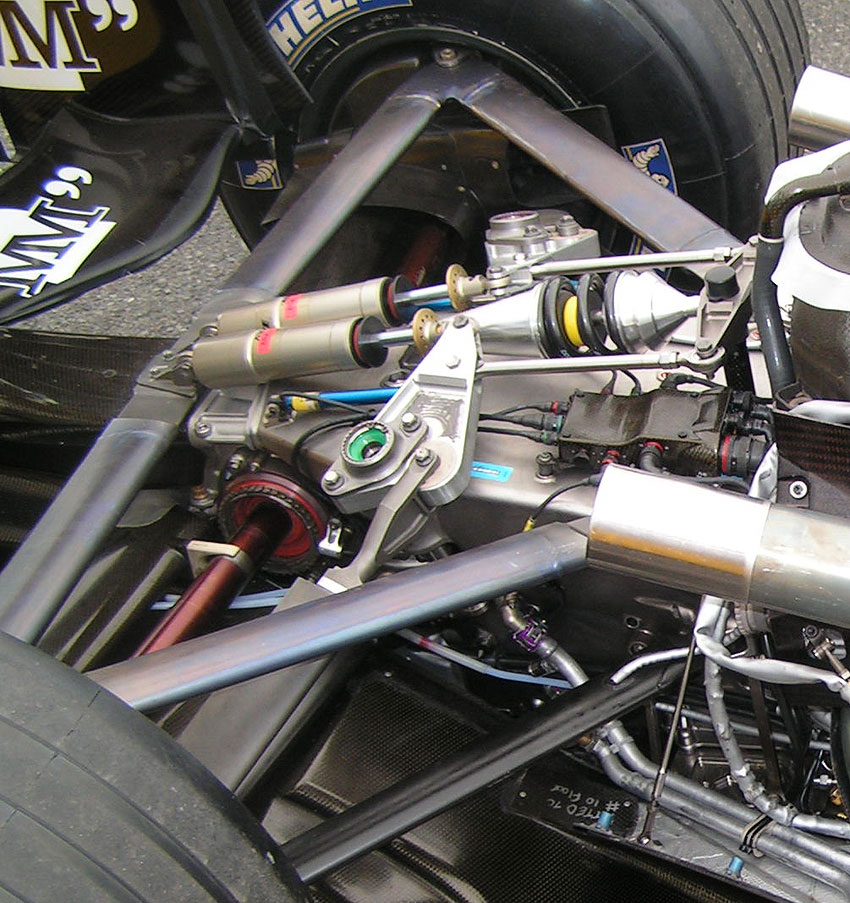
Interesting, I have never really looked at f1 suspension before. So the torsion bars are for individual wheel movement, the spring only really kicks in when both wheels move.
What's all this about Renaults tuned mass dampers? They actually added weight to the shock??
Weren't they using rotary dampers too at some stage??
Torsion bars are for each wheel yes. They are in line with the green things, the pivots of the bell cranks. The coil spring controls the ride height. The anti-roll bar is the carbon tube that the third spring and the pull rods are connected to.
Interesting, I have never really looked at f1 suspension before. So the torsion bars are for individual wheel movement, the spring only really kicks in when both wheels move.
What's all this about Renaults tuned mass dampers? They actually added weight to the shock??
Weren't they using rotary dampers too at some stage??
I don't know much about the Renault tuned mass setup. I think it worked like a kanagroo's tail. It balanced the rest of the car. If the muspension moved one way, it went the other, so the net effect was 0. There's a very small write up on a generic version of it in the Bosch Automotive Handbook if you've got access to it. Caterpillar underground LHDs have a similar setup which works beautifully.
Nearly all teams use rotary damper now. Sachs to be specific. That photo is pretty old by the look of it. Steel wishbones, bulky gearbox etc.
Since you seem to know a fair bit about current F1 tech, do you know what style the inner pivot is on the control arms. From the picture above it looks like a living hinge as I don't see any bearings, bushings, or heim joints but maybe they are tucked away somewhere. We were talking about this at work and actually looking at the same picture trying to figure it out.
There is no pivot as such. They have a flexible member. In that photo it's the flat strip near the gearbox. They have carbon ones now. Heim joints had too much compliance apparently.Since you seem to know a fair bit about current F1 tech, do you know what style the inner pivot is on the control arms. From the picture above it looks like a living hinge as I don't see any bearings, bushings, or heim joints but maybe they are tucked away somewhere. We were talking about this at work and actually looking at the same picture trying to figure it out.

That looks to be a flex hinge- probably Ti (I'm guessing that's a Renault.) If I remember correctly John Barnard first used this on a Ferrari in the early 90's.
Rotary dampers aren't really anything new- they've been around forever in one form or another. Suzuki had a street bike (was it the TL100?) that used a rotary damper made by Kayaba. The idea was that you could separate spring and damper so you could have different rising rates for damper and spring (Riley and Scott used this on some successful prototype race cars). You're also not constrained by the inner spring diameter regarding the size of the piston so a rotary vane damper can move a lot of fluid. You also don't have to accommodate for the change in internal volume that the piston rod on a traditional damper needs (unless it's a through shaft damper like recent Ohlins and Sachs dampers.)
The TL1000 rotary damper was never really well received- I don't really know why. Maybe they leaked or something- I would imagine sealing them would be much more difficult than a traditional damper and I would think that the required internal seals would have more friction (at least back then). Yamaha and Ohlins also worked on a carbon flag spring/rotary damper MX bike but it never really went anywhere. There was even a patent filed by Yamaha that had a carbon leaf spring mounted inside the swingarm.
I would imagine the move to rotary dampers in F1 probably has a lot to do with packaging. Mass dampers were used in F1 by Renault (and later found to be illegal- it was classified as a movable aerodynamic device) to control frequency/resonance and to help the car maintain a more consistent ride height, improving the aerodynamics. Koni developed a similar frequency control system in their FSD (frequency selective damping) system. FDS could potentially have some use in bikes.
I could be completely wrong about this but I think the problem with current platform damping is that it tends to set a threshold and then over damp anything below that threshold in order to improve pedaling performance (due to rider weight transfer- every bike I’ve ever ridden bobs when set up for good small bump compliance) when what we really want is a damper that can isolate the particular frequency that the damper moves at while pedaling during an out of the saddle effort- this would allow the damper to discriminate between a rider input and a bump input on a very selective level without harming small bump sensitivity. It would be pretty neat to see the technology applied to a mountain bike damper. It wouldn’t be too difficult to measure the frequency at the damper for different weight riders and then provide an adjustable or replaceable valve to allow the rider to tune the damper to that frequency.
Rotary dampers aren't really anything new- they've been around forever in one form or another. Suzuki had a street bike (was it the TL100?) that used a rotary damper made by Kayaba. The idea was that you could separate spring and damper so you could have different rising rates for damper and spring (Riley and Scott used this on some successful prototype race cars). You're also not constrained by the inner spring diameter regarding the size of the piston so a rotary vane damper can move a lot of fluid. You also don't have to accommodate for the change in internal volume that the piston rod on a traditional damper needs (unless it's a through shaft damper like recent Ohlins and Sachs dampers.)
The TL1000 rotary damper was never really well received- I don't really know why. Maybe they leaked or something- I would imagine sealing them would be much more difficult than a traditional damper and I would think that the required internal seals would have more friction (at least back then). Yamaha and Ohlins also worked on a carbon flag spring/rotary damper MX bike but it never really went anywhere. There was even a patent filed by Yamaha that had a carbon leaf spring mounted inside the swingarm.
I would imagine the move to rotary dampers in F1 probably has a lot to do with packaging. Mass dampers were used in F1 by Renault (and later found to be illegal- it was classified as a movable aerodynamic device) to control frequency/resonance and to help the car maintain a more consistent ride height, improving the aerodynamics. Koni developed a similar frequency control system in their FSD (frequency selective damping) system. FDS could potentially have some use in bikes.
I could be completely wrong about this but I think the problem with current platform damping is that it tends to set a threshold and then over damp anything below that threshold in order to improve pedaling performance (due to rider weight transfer- every bike I’ve ever ridden bobs when set up for good small bump compliance) when what we really want is a damper that can isolate the particular frequency that the damper moves at while pedaling during an out of the saddle effort- this would allow the damper to discriminate between a rider input and a bump input on a very selective level without harming small bump sensitivity. It would be pretty neat to see the technology applied to a mountain bike damper. It wouldn’t be too difficult to measure the frequency at the damper for different weight riders and then provide an adjustable or replaceable valve to allow the rider to tune the damper to that frequency.
Last edited:
*lifted direct from distilled mag*
We got Peter Schmid of Solid Bikes/Reverse Components on the phone to get you some more details on their revolutionary new carbon fiber spring prototype.
“The spring came out of the relationship between Reverse Components and CS Federleicht, a German company coming out of a university. They are a tremendously smart group of people, and are comprised of one professor and two engineers. I met with them one and a half years ago and learned that they were experts in all kinds of springs. Now our goal is to bring a new, lightweight spring to the market, and this is our first prototype you see here. The spring is made using top-secret technology which will be patented in the future, and our target between now and the next Eurobike is to develop the spring for use with the Cane Creek Double Barrel shock. At the moment we have at the very least a 50 per cent weight reduction over a steel spring. We can say this for sure right now, but there’s a long way to go and it may be that the weight will come down even more.”
Will the carbon spring be feasible for downhill use?
“Yes that’s our main target area. We will be testing with the Solid A-Class factory team in partnership with our sponsor Cane Creek, who are also a very smart group of people. I am looking forward to having our team riders using the carbon springs with their Double Barrel shocks next season. I feel that this is very like the first time people showed disc brakes on a mountainbike. If you compare what we had at the time to the sleek, well-functioning brakes we have now, and the fact that almost every bike out there runs disc brakes now, I think that carbon springs will be just as refined and will feature not only on the back of the bike but also in the forks or in rear derailleurs. CS Federleicht make springs for all kinds of specialist applications so I think the carbon springs will move out from the bicycle industry into other industries like cars and motorcycles, which will be a first considering it’s usually other industries’ technologies that influence the bike industry. But in saying this, our immediate target is to make it work on downhill rear shocks first.”
How do you view the strength and reliability of a carbon spring?
“I really believe in them, because the people I am working with are such professionals and they have developed a really amazing technology. This is not something made in a guy’s backyard, they are based on incredibly complex mathematical study and they have a lot of experience already with carbon fiber products. These guys are even developing new kinds of springs for use in skyscrapers to offset the effects of earthquakes, so I know these people are one of, if not the best, choices in Europe and possibly the world to be partnering with on this project. Maybe now we can get rid of all the air forks and shocks, as we know the performance from a spring is always better, so if we can match the weight then they will no longer be needed. Again it’s a long way off, but I’m hoping that the shock bodies will even change to best accommodate the properties of the carbon spring, rather than us fitting the spring to match the existing shock bodies, perhaps they will re-design the shock bodies to take advantage of the full-benefits of the new springs and also to save weight.”
We got Peter Schmid of Solid Bikes/Reverse Components on the phone to get you some more details on their revolutionary new carbon fiber spring prototype.
“The spring came out of the relationship between Reverse Components and CS Federleicht, a German company coming out of a university. They are a tremendously smart group of people, and are comprised of one professor and two engineers. I met with them one and a half years ago and learned that they were experts in all kinds of springs. Now our goal is to bring a new, lightweight spring to the market, and this is our first prototype you see here. The spring is made using top-secret technology which will be patented in the future, and our target between now and the next Eurobike is to develop the spring for use with the Cane Creek Double Barrel shock. At the moment we have at the very least a 50 per cent weight reduction over a steel spring. We can say this for sure right now, but there’s a long way to go and it may be that the weight will come down even more.”
Will the carbon spring be feasible for downhill use?
“Yes that’s our main target area. We will be testing with the Solid A-Class factory team in partnership with our sponsor Cane Creek, who are also a very smart group of people. I am looking forward to having our team riders using the carbon springs with their Double Barrel shocks next season. I feel that this is very like the first time people showed disc brakes on a mountainbike. If you compare what we had at the time to the sleek, well-functioning brakes we have now, and the fact that almost every bike out there runs disc brakes now, I think that carbon springs will be just as refined and will feature not only on the back of the bike but also in the forks or in rear derailleurs. CS Federleicht make springs for all kinds of specialist applications so I think the carbon springs will move out from the bicycle industry into other industries like cars and motorcycles, which will be a first considering it’s usually other industries’ technologies that influence the bike industry. But in saying this, our immediate target is to make it work on downhill rear shocks first.”
How do you view the strength and reliability of a carbon spring?
“I really believe in them, because the people I am working with are such professionals and they have developed a really amazing technology. This is not something made in a guy’s backyard, they are based on incredibly complex mathematical study and they have a lot of experience already with carbon fiber products. These guys are even developing new kinds of springs for use in skyscrapers to offset the effects of earthquakes, so I know these people are one of, if not the best, choices in Europe and possibly the world to be partnering with on this project. Maybe now we can get rid of all the air forks and shocks, as we know the performance from a spring is always better, so if we can match the weight then they will no longer be needed. Again it’s a long way off, but I’m hoping that the shock bodies will even change to best accommodate the properties of the carbon spring, rather than us fitting the spring to match the existing shock bodies, perhaps they will re-design the shock bodies to take advantage of the full-benefits of the new springs and also to save weight.”
It could be noted that a well designed titanium-spring can save almost 60% of the weight compared to a steel spring with the same charesteristics/spring properties. So 50% for the carbon doesn't sound impressive.
Last edited:
On Jun 26th 2012, the AUDI R8 e-tron has set a new lap record on the Nürburgring for a (nearby) production vehicle with an electric drive system by posting a time of 8:09.099 minutes. The record setting run was achieved with racing driver Markus WINKELHOCK at the wheel.
That AUDI R8 e-tron sports FRP coil springs made by SOGEFI/IT, based on a patent granted by Dr. Max SARDOU/FR. BTW, it will be the first series car fitted with FRP coil springs when it will go in a limited series production in November 2012. Furthermore, AUDI communicated they will fit another models of their product lineup with this new type of coil springs stepwise from 2013.
Hopefully FRP coil springs will make it in MTB coilover shocks, too.
Any news on CS.FEDERLEICHT.de?
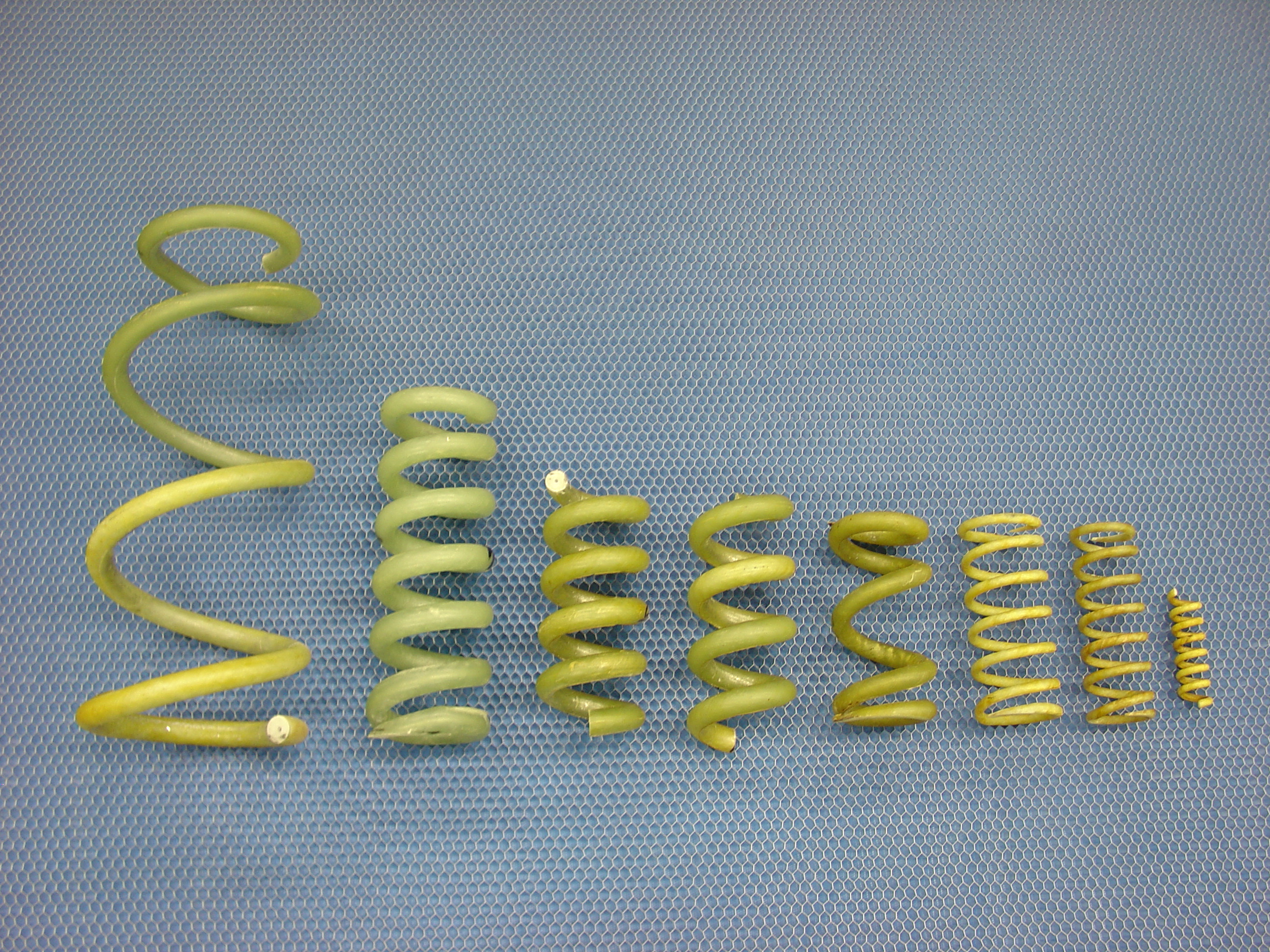

That AUDI R8 e-tron sports FRP coil springs made by SOGEFI/IT, based on a patent granted by Dr. Max SARDOU/FR. BTW, it will be the first series car fitted with FRP coil springs when it will go in a limited series production in November 2012. Furthermore, AUDI communicated they will fit another models of their product lineup with this new type of coil springs stepwise from 2013.
Hopefully FRP coil springs will make it in MTB coilover shocks, too.
Any news on CS.FEDERLEICHT.de?


Fresh from Science 337 (2012) 6098, 1087-1091 today.
Clues how to design FRP coil springs of the after next generation:

Fig. courtesy Science Mag.
How the Cucumber Tendril Coils and Overwinds

Clues how to design FRP coil springs of the after next generation:
Fig. courtesy Science Mag.
How the Cucumber Tendril Coils and Overwinds

I think carbonz would have a great application as leaf springs, especially in a dw style double link bike. Replace one link with a carbonz plate and ditch the steel spring entirely. Saves weight and doesn't compromise stiffness. A rotary damper would be the ultimate in clean packaging though. Foes did a leaf spring bike, it was pretty neat.
Will debut later this year on a "upper mid-size model"
Audi has announced plans to begin using glass fiber-reinforced polymer (GFRP) springs.
Set to debut in an "upper mid-size model before the end of the year," the GFRP springs are thicker and larger than conventional steel springs but are about 40 percent lighter. Audi says each spring weighs about 1.6 kilograms (3.5 lb), while a comparable steel spring tips the scale at roughly 2.7 kilograms (6.0 lb). This might not sound like much but Audi says the springs will reduce the car's weight by approximately 4.4 kilograms (9.7 lb) and half of that is unsprung mass.
Besides being lightweight, the springs are resilient as they will not corrode and are impervious to chemicals such as wheel cleaners.
According to Audi Technical Development boss Dr. Ulrich Hackenberg, The GFRP springs save weight at a crucial location in the chassis system. We are therefore making driving more precise and enhancing vibrational comfort."

So let´s try SOGEFI GFRP coil springs for MTB shocks!
Audi has announced plans to begin using glass fiber-reinforced polymer (GFRP) springs.
Set to debut in an "upper mid-size model before the end of the year," the GFRP springs are thicker and larger than conventional steel springs but are about 40 percent lighter. Audi says each spring weighs about 1.6 kilograms (3.5 lb), while a comparable steel spring tips the scale at roughly 2.7 kilograms (6.0 lb). This might not sound like much but Audi says the springs will reduce the car's weight by approximately 4.4 kilograms (9.7 lb) and half of that is unsprung mass.
Besides being lightweight, the springs are resilient as they will not corrode and are impervious to chemicals such as wheel cleaners.
According to Audi Technical Development boss Dr. Ulrich Hackenberg, The GFRP springs save weight at a crucial location in the chassis system. We are therefore making driving more precise and enhancing vibrational comfort."

So let´s try SOGEFI GFRP coil springs for MTB shocks!

-
This site uses cookies to help personalise content, tailor your experience and to keep you logged in if you register.
By continuing to use this site, you are consenting to our use of cookies.

